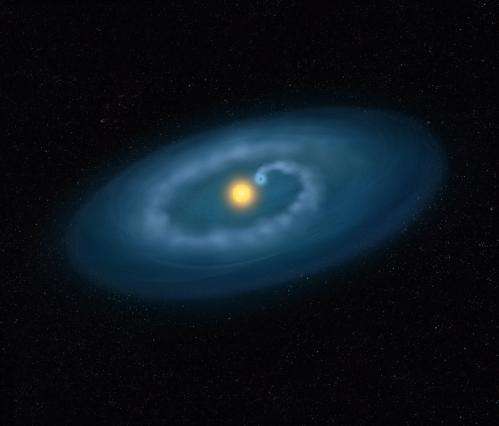Planet 'devoured in secret' by its own sun

(Phys.org)—A planet roughly 1.4 times the size of Jupiter is being consumed by its own star behind a shroud thanks to a magnesium veil absorbing all of certain light wavelengths, according to new observations by the Hubble Space Telescope (HST).
WASP-12 b, originally spotted in 2008, is a gas giant planet orbiting extremely close to its parent star. The distance between the star and planet is so small that the planet completes an orbit of its star in just over one Earth day. This proximity has "boiled off" a superheated gas cloud roughly three times the radius of Jupiter which feeds the star. However, some of this gas is moving out towards interstellar space, creating a shroud around the star.
The gas shroud is thin, and barely noticeable in optical light, but the new observations were made with HST using near-UV light. The team discovered that one element in the cloud is magnesium, which is extremely efficient at absorbing near-UV light. These wavelengths are extremely sensitive to the presence of tenuous gas, and in them the star can appear completely invisible.
The study was made by researchers from the UK's Wide Angle Search for Planets (WASP) consortium, who originally found the planet in 2008, as well experts on the Cosmic Origins Spectrograph aboard the HST, stellar activity, and interstellar absorption from the Center for Astrophysics and Space Astronomy at the University of Colorado.
Senior Lecturer in Astronomy at The Open University Dr Carole Haswell, who led the study, said that a structure like this had never before been observed around a star, adding: "It's as though a veil has been drawn over the planet's demise."
The paper, Near-UV Absorption, Chromospheric Activity, and Star-Planet Interactions in the WASP-12 system Haswell et al 2012, was published in The Astrophysical Journal on the 20th of November.
Journal information: Astrophysical Journal
Provided by The Open University




















